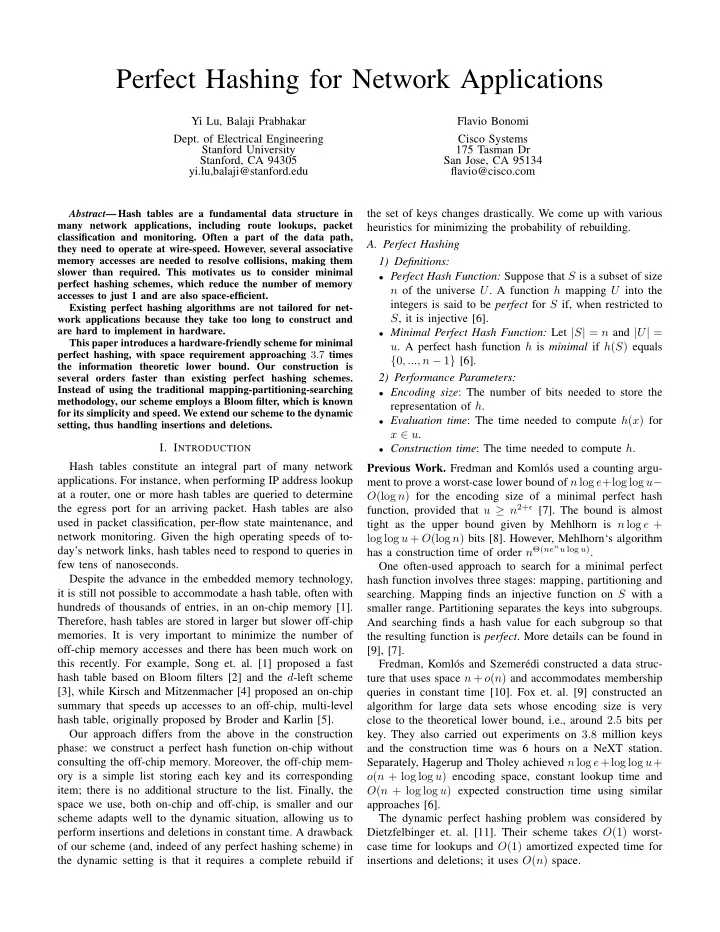

Perfect Hashing for Network Applications Yi Lu, Balaji Prabhakar Flavio Bonomi Dept. of Electrical Engineering Cisco Systems Stanford University 175 Tasman Dr Stanford, CA 94305 San Jose, CA 95134 yi.lu,balaji@stanford.edu flavio@cisco.com the set of keys changes drastically. We come up with various Abstract — Hash tables are a fundamental data structure in many network applications, including route lookups, packet heuristics for minimizing the probability of rebuilding. classification and monitoring. Often a part of the data path, A. Perfect Hashing they need to operate at wire-speed. However, several associative memory accesses are needed to resolve collisions, making them 1) Definitions: slower than required. This motivates us to consider minimal • Perfect Hash Function: Suppose that S is a subset of size perfect hashing schemes, which reduce the number of memory n of the universe U . A function h mapping U into the accesses to just 1 and are also space-efficient. integers is said to be perfect for S if, when restricted to Existing perfect hashing algorithms are not tailored for net- S , it is injective [6]. work applications because they take too long to construct and are hard to implement in hardware. • Minimal Perfect Hash Function: Let | S | = n and | U | = This paper introduces a hardware-friendly scheme for minimal u . A perfect hash function h is minimal if h ( S ) equals perfect hashing, with space requirement approaching 3 . 7 times { 0 , ..., n − 1 } [6]. the information theoretic lower bound. Our construction is 2) Performance Parameters: several orders faster than existing perfect hashing schemes. Instead of using the traditional mapping-partitioning-searching • Encoding size : The number of bits needed to store the methodology, our scheme employs a Bloom filter, which is known representation of h . for its simplicity and speed. We extend our scheme to the dynamic • Evaluation time : The time needed to compute h ( x ) for setting, thus handling insertions and deletions. x ∈ u . I. I NTRODUCTION • Construction time : The time needed to compute h . Hash tables constitute an integral part of many network Previous Work. Fredman and Koml´ os used a counting argu- applications. For instance, when performing IP address lookup ment to prove a worst-case lower bound of n log e +log log u − at a router, one or more hash tables are queried to determine O (log n ) for the encoding size of a minimal perfect hash function, provided that u ≥ n 2+ ǫ [7]. The bound is almost the egress port for an arriving packet. Hash tables are also used in packet classification, per-flow state maintenance, and tight as the upper bound given by Mehlhorn is n log e + network monitoring. Given the high operating speeds of to- log log u + O (log n ) bits [8]. However, Mehlhorn‘s algorithm has a construction time of order n Θ( ne n u log u ) . day’s network links, hash tables need to respond to queries in few tens of nanoseconds. One often-used approach to search for a minimal perfect Despite the advance in the embedded memory technology, hash function involves three stages: mapping, partitioning and it is still not possible to accommodate a hash table, often with searching. Mapping finds an injective function on S with a hundreds of thousands of entries, in an on-chip memory [1]. smaller range. Partitioning separates the keys into subgroups. Therefore, hash tables are stored in larger but slower off-chip And searching finds a hash value for each subgroup so that memories. It is very important to minimize the number of the resulting function is perfect . More details can be found in off-chip memory accesses and there has been much work on [9], [7]. this recently. For example, Song et. al. [1] proposed a fast Fredman, Koml´ os and Szemer´ edi constructed a data struc- hash table based on Bloom filters [2] and the d -left scheme ture that uses space n + o ( n ) and accommodates membership [3], while Kirsch and Mitzenmacher [4] proposed an on-chip queries in constant time [10]. Fox et. al. [9] constructed an summary that speeds up accesses to an off-chip, multi-level algorithm for large data sets whose encoding size is very hash table, originally proposed by Broder and Karlin [5]. close to the theoretical lower bound, i.e., around 2 . 5 bits per Our approach differs from the above in the construction key. They also carried out experiments on 3 . 8 million keys phase: we construct a perfect hash function on-chip without and the construction time was 6 hours on a NeXT station. consulting the off-chip memory. Moreover, the off-chip mem- Separately, Hagerup and Tholey achieved n log e +log log u + ory is a simple list storing each key and its corresponding o ( n + log log u ) encoding space, constant lookup time and item; there is no additional structure to the list. Finally, the O ( n + log log u ) expected construction time using similar space we use, both on-chip and off-chip, is smaller and our approaches [6]. scheme adapts well to the dynamic situation, allowing us to The dynamic perfect hashing problem was considered by perform insertions and deletions in constant time. A drawback Dietzfelbinger et. al. [11]. Their scheme takes O (1) worst- case time for lookups and O (1) amortized expected time for of our scheme (and, indeed of any perfect hashing scheme) in insertions and deletions; it uses O ( n ) space. the dynamic setting is that it requires a complete rebuild if
Recommend
More recommend